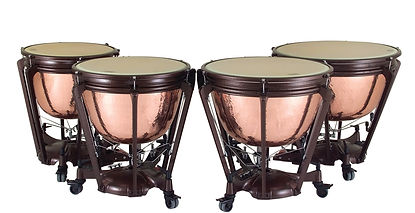Music To Your Ears
website on band instruments
Timpani
General info:
Timpani are musical instruments in the percussion family.They consist of a skin called a head stretched over a large bowl traditionally made of copper. They are played by striking the head with a timpani mallet. Timpani is an Italian plural, the singular of which is timpano. A musician who plays the timpani is a timpanist.
History:
The first recorded use of the timpani was in religious ceremonies by the Hebrews.
Arabic nakers, the direct ancestors of most timpani, were brought to Europe in the 13th century, mainly for military uses. In 1457, a Hungarian legation sent by King Ladislaus V carried larger timpani mounted on horseback to the court of King Charles VII in France. These drums evolved together with trumpets to be the primary instruments of the cavalry. Over the next two centuries, a number of technical improvements were made to timpani. In the 15th century, heads began to be attached and tensioned by a counterhoop that was tied directly to the shell. In the early 16th century, the bindings were replaced by screws. This allowed timpani to become tunable instruments of definite pitch.
Jean-Baptiste Lully is the first known composer to have scored for timpani, which he included in the orchestra for his 1675 opera Thésée.
Until the late 19th century, timpani were hand-tuned with T-shaped handles, called taps, which altered the tension in the head when turned by players. The first 'machine' timpani, with a single tuning handle, was developed in 1812. The first pedal timpani originated in Dresden in the 1870s and are called Dresden timpani for this reason.
Range:
Each timpano has its own respective range.
D timpano (bass timpano: 75–80 cm): C2, D2 – H2, C3
G timpano (large timpano: 65–70cm): E2, F2 – D3, E3
C timpano (small timpano: 60–65cm): Ab2, Bb2 – G3, Ab3
F timpano (high timpano: 55–60 cm): C3 – G#3
A timpano (high timpano: 50–60 cm): C3, D3 – Bb3, C#4
B timpano (45–50 cm): G3 – C4
Role:
Timpani are a central part of the percussion family because they support rhythm, melody and harmony.
Foreign names:
Pauken ---- German
Timbales ---- French
Timpani ---- Italian
Famous pieces:
